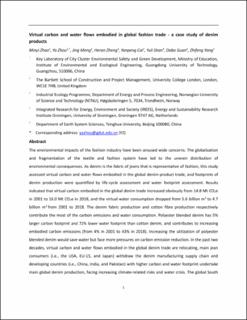| dc.description.abstract | The environmental impacts of the fashion industry have been aroused wide concerns. The globalization and fragmentation of the textile and fashion system have led to the uneven distribution of environmental consequences. As denim is the fabric of jeans that is representative of fashion, this study assessed virtual carbon and water flows embodied in the global denim-product trade, and footprints of denim production were quantified by life-cycle assessment and water footprint assessment. Results indicated that virtual carbon embodied in the global denim trade increased obviously from 14.8 Mt CO2e in 2001 to 16.0 Mt CO2e in 2018, and the virtual water consumption dropped from 5.6 billion m3 to 4.7 billion m3 from 2001 to 2018. The denim fabric production and cotton fibre production respectively contribute the most of the carbon emissions and water consumption. Polyester blended denim has 5% larger carbon footprint and 72% lower water footprint than cotton denim, and contributes to increasing embodied carbon emissions (from 4% in 2001 to 43% in 2018). Increasing the utilization of polyester blended denim would save water but face more pressures on carbon emission reduction. In the past two decades, virtual carbon and water flows embodied in the global denim trade are relocating, main jean consumers (i.e., the USA, EU-15, and Japan) withdraw the denim manufacturing supply chain and developing countries (i.e., China, India, and Pakistan) with higher carbon and water footprint undertake main global denim production, facing increasing climate-related risks and water crisis. The South-South cooperation helps share successful experiences, save production cost, and lessen resource consumption and environmental emissions. The production and consumption of denim should be shifted to circular and sustainable ways and new business models are required. The analysis framework can provide the basis for exploring environmental flows of product-level trade, and results can offer a basis for environmental policies and control strategies of the fashion industry, and as well as the sustainable production and consumption of garment. | en_US |

